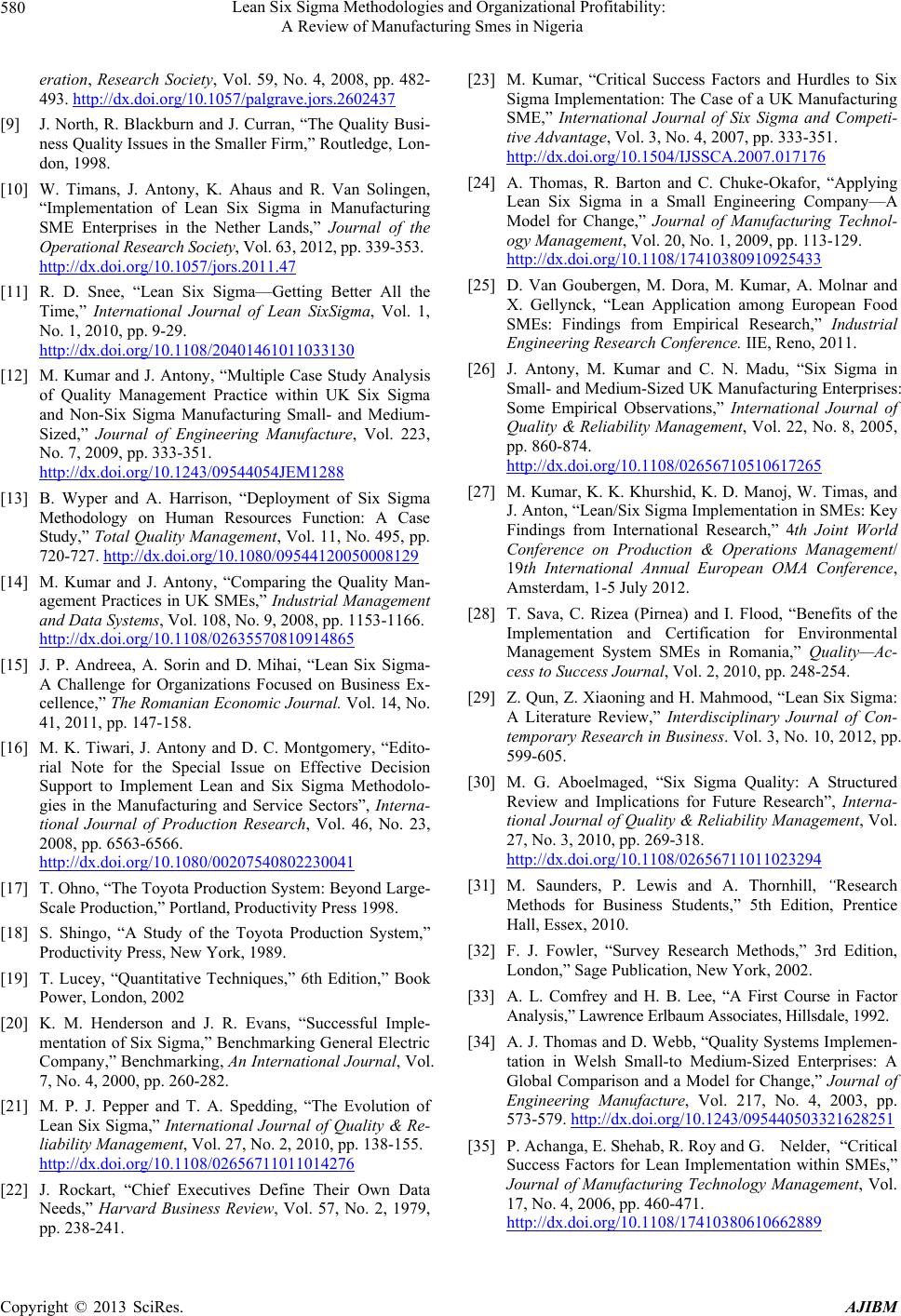
Lean Six Sigma Methodologies and Organizational Profitability:
A Review of Manufacturing Smes in Nigeria
Copyright © 2013 SciRes. AJIBM
580
eration, Research Society, Vol. 59, No. 4, 2008, pp. 482-
493. http://dx.doi.org/10.1057/palgrave.jors.2602437
[9] J. North, R. Blackburn and J. Curran, “The Quality Busi-
ness Quality Issues in the Smaller Firm,” Routledge, Lon-
don, 1998.
[10] W. Timans, J. Antony, K. Ahaus and R. Van Solingen,
“Implementation of Lean Six Sigma in Manufacturing
SME Enterprises in the Nether Lands,” Journal of the
Operational Research Society, Vol. 63, 2012, pp. 339-353.
http://dx.doi.org/10.1057/jors.2011.47
[11] R. D. Snee, “Lean Six Sigma—Getting Better All the
Time,” International Journal of Lean SixSigma, Vol. 1,
No. 1, 2010, pp. 9-29.
http://dx.doi.org/10.1108/20401461011033130
[12] M. Kumar and J. Antony, “Multiple Case Study Analysis
of Quality Management Practice within UK Six Sigma
and Non-Six Sigma Manufacturing Small- and Medium-
Sized,” Journal of Engineering Manufacture, Vol. 223,
No. 7, 2009, pp. 333-351.
http://dx.doi.org/10.1243/09544054JEM1288
[13] B. Wyper and A. Harrison, “Deployment of Six Sigma
Methodology on Human Resources Function: A Case
Study,” Total Quality Management, Vol. 11, No. 495, pp.
720-727. http://dx.doi.org/10.1080/09544120050008129
[14] M. Kumar and J. Antony, “Comparing the Quality Man-
agement Practices in UK SMEs,” Industrial Management
and Data Systems, Vol. 108, No. 9, 2008, pp. 1153-1166.
http://dx.doi.org/10.1108/02635570810914865
[15] J. P. Andreea, A. Sorin and D. Mihai, “Lean Six Sigma-
A Challenge for Organizations Focused on Business Ex-
cellence,” The Romanian Economic Journal. Vol. 14, No.
41, 2011, pp. 147-158.
[16] M. K. Tiwari, J. Antony and D. C. Montgomery, “Edito-
rial Note for the Special Issue on Effective Decision
Support to Implement Lean and Six Sigma Methodolo-
gies in the Manufacturing and Service Sectors”, Interna-
tional Journal of Production Research, Vol. 46, No. 23,
2008, pp. 6563-6566.
http://dx.doi.org/10.1080/00207540802230041
[17] T. Ohno, “The Toyota Production System: Beyond Large-
Scale Production,” Portland, Productivity Press 1998.
[18] S. Shingo, “A Study of the Toyota Production System,”
Productivity Press, New York, 1989.
[19] T. Lucey, “Quantitative Techniques,” 6th Edition,” Book
Power, London, 2002
[20] K. M. Henderson and J. R. Evans, “Successful Imple-
mentation of Six Sigma,” Benchmarking General Electric
Company,” Benchmarking, An International Journal, Vol.
7, No. 4, 2000, pp. 260-282.
[21] M. P. J. Pepper and T. A. Spedding, “The Evolution of
Lean Six Sigma,” International Journal of Quality & Re-
liability Management, Vol. 27, No. 2, 2010, pp. 138-155.
http://dx.doi.org/10.1108/02656711011014276
[22] J. Rockart, “Chief Executives Define Their Own Data
Needs,” Harvard Business Review, Vol. 57, No. 2, 1979,
pp. 238-241.
[23] M. Kumar, “Critical Success Factors and Hurdles to Six
Sigma Implementation: The Case of a UK Manufacturing
SME,” International Journal of Six Sigma and Competi-
tive Advantage, Vol. 3, No. 4, 2007, pp. 333-351.
http://dx.doi.org/10.1504/IJSSCA.2007.017176
[24] A. Thomas, R. Barton and C. Chuke-Okafor, “Applying
Lean Six Sigma in a Small Engineering Company—A
Model for Change,” Journal of Manufacturing Technol-
ogy Management, Vol. 20, No. 1, 2009, pp. 113-129.
http://dx.doi.org/10.1108/17410380910925433
[25] D. Van Goubergen, M. Dora, M. Kumar, A. Molnar and
X. Gellynck, “Lean Application among European Food
SMEs: Findings from Empirical Research,” Industrial
Engineering Research Conference. IIE, Reno, 2011.
[26] J. Antony, M. Kumar and C. N. Madu, “Six Sigma in
Small- and Medium-Sized UK Manufacturing Enterprises:
Some Empirical Observations,” International Journal of
Quality & Reliability Management, Vol. 22, No. 8, 2005,
pp. 860-874.
http://dx.doi.org/10.1108/02656710510617265
[27] M. Kumar, K. K. Khurshid, K. D. Manoj, W. Timas, and
J. Anton, “Lean/Six Sigma Implementation in SMEs: Key
Findings from International Research,” 4th Joint World
Conference on Production & Operations Management/
19th International Annual European OMA Conference,
Amsterdam, 1-5 July 2012.
[28] T. Sava, C. Rizea (Pirnea) and I. Flood, “Benefits of the
Implementation and Certification for Environmental
Management System SMEs in Romania,” Quality—Ac-
cess to Success Journal, Vol. 2, 2010, pp. 248-254.
[29] Z. Qun, Z. Xiaoning and H. Mahmood, “Lean Six Sigma:
A Literature Review,” Interdisciplinary Journal of Con-
temporary Research in Business. Vol. 3, No. 10, 2012, pp.
599-605.
[30] M. G. Aboelmaged, “Six Sigma Quality: A Structured
Review and Implications for Future Research”, Interna-
tional Journal of Quality & Reliability Management, Vol.
27, No. 3, 2010, pp. 269-318.
http://dx.doi.org/10.1108/02656711011023294
[31] M. Saunders, P. Lewis and A. Thornhill, “Research
Methods for Business Students,” 5th Edition, Prentice
Hall, Essex, 2010.
[32] F. J. Fowler, “Survey Research Methods,” 3rd Edition,
London,” Sage Publication, New York, 2002.
[33] A. L. Comfrey and H. B. Lee, “A First Course in Factor
Analysis,” Lawrence Erlbaum Associates, Hillsdale, 1992.
[34] A. J. Thomas and D. Webb, “Quality Systems Implemen-
tation in Welsh Small-to Medium-Sized Enterprises: A
Global Comparison and a Model for Change,” Journal of
Engineering Manufacture, Vol. 217, No. 4, 2003, pp.
573-579. http://dx.doi.org/10.1243/095440503321628251
[35] P. Achanga, E. Shehab, R. Roy and G. Nelder, “Critical
Success Factors for Lean Implementation within SMEs,”
Journal of Manufacturing Technology Management, Vol.
17, No. 4, 2006, pp. 460-471.
http://dx.doi.org/10.1108/17410380610662889